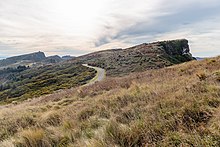| Tingena macarella | |
|---|---|

| |
| Male lectotype | |
| Scientific classification | |
| Domain: | Eukaryota |
| Kingdom: | Animalia |
| Phylum: | Arthropoda |
| Class: | Insecta |
| Order: | Lepidoptera |
| Family: | Oecophoridae |
| Genus: | Tingena |
| Species: | T. macarella |
| Binomial name | |
| Tingena macarella (Meyrick, 1883) | |
| Synonyms | |
| |
Tingena macarella is a species of moth in the family Oecophoridae. It is endemic to New Zealand and is found on both the North and South Islands. Adults of this species are on the wing from November until February. This species is attracted to light and the larvae are litter feeders.
Taxonomy

This species was first described by Edward Meyrick in 1883 using specimens collected in Christchurch in January and named Oecophora macarella. Meyrick went on to give a more detailed description in 1884. In 1915 Meyrick placed this species within the Borkhausenia genus. In 1926 Alfred Philpott was unable to study the genitalia of the male of this species as no species were held in New Zealand collections. George Hudson discussed this species under the name B. macarella in his 1928 publication The butterflies and moths of New Zealand. In 1988 J. S. Dugdale placed this species in the genus Tingena. The male lectotype, collected in the Port Hills, is held at the Natural History Museum, London.
Description
Meyrick first described this species as follows:
Fore wings pale yellow, base of costa blackish, sometimes a mark on fold and bar from anal angle obscurely dark fuscous; hind wings whitish-grey; thorax dark fuscous, posterior margin yellowish.
Meyrick went on to do a more detailed description as follows:
Male, female. — 12+1⁄2-14 mm. Head pale yellow. Palpi whitish-yellow, basal half of both joints externally irrorated with dark fuscous. Antennae ochreous-whitish, basal joint dark fuscous except at apex. Thorax dark fuscous, with small lateral and posterior pale yellowish spots. Abdomen grey-whitish. Anterior legs dark fuscous; middle legs ochreous-whitish irrorated with dark fuscous, except at apex of joints; posterior legs ochreous-whitisb. Forewings moderate, costa moderately arched, apex blunt-pointed, hindmargin very obliquely rounded; pale yellow, somewhat suffused with deeper yellow; costa dark fuscous towards base; sometimes a few dark fuscous scales on fold at 1⁄3, and on a bar from disc to anal angle : cilia pale yellow, with several rows of grey points, and a darker grey shade before tips. Hindwings whitish-grey; cilia grey-whitish.
Meyrick suggested that this species could be distinguished by its "pale yellow colouring, less defined basal mark on costa and the almost wholly dark fuscous thorax".
Distribution
This species is endemic to New Zealand and has been observed on both the North and South Islands including in Wellington, Kapiti Island and Christchurch.
Behaviour
The adults of this species are on the wing from November to February. T. macarella are attracted to light.
Hosts
The larvae of this species are litter feeders including on the litter of Festuca.
References
- ^ Gordon, Dennis P., ed. (2010). New Zealand inventory of biodiversity: Kingdom animalia: chaetognatha, ecdysozoa, ichnofossils. Vol. 2. p. 462. ISBN 978-1-877257-93-3. OCLC 973607714. OL 25288394M. Wikidata Q45922947.
- ^ Dugdale , J. S. (23 September 1988). "Lepidoptera - annotated catalogue, and keys to family-group taxa". Fauna of New Zealand. 14. Department of Scientific and Industrial Research: 103. doi:10.7931/J2/FNZ.14. ISSN 0111-5383. Wikidata Q45083134.
- ^ Edward Meyrick (September 1883). "Descriptions of New Zealand Micro-Lepidoptera.—III.—Oecophoridae". New Zealand Journal of Science. 1: 524. Wikidata Q106368126.
- ^ Edward Meyrick (1884). "Descriptions of New Zealand Microlepidoptera. III. Oecophoridae". Transactions and Proceedings of the New Zealand Institute. 16: 42–43. ISSN 1176-6158. Wikidata Q63976486.
- ^ E. Meyrick (12 July 1915). "Revision of New Zealand Tineina". Transactions and Proceedings of the New Zealand Institute. 47: 212. ISSN 1176-6158. Wikidata Q63123349.
- Alfred Philpott (1926). "List of New Zealand species of Borkhausenia (Oecophoridae: Lepidoptera), including new species". Transactions and Proceedings of the New Zealand Institute. 56: 399–413. ISSN 1176-6158. Wikidata Q110157185.
- ^ Hudson, G. V. (1928), The butterflies and moths of New Zealand, Illustrator: George Hudson, Wellington: Ferguson and Osborn Limited, p. 263, LCCN 88133764, OCLC 25449322, Wikidata Q58593286
- Davis, Mark; Lettink, Marieke; Patrick, Brian (January 2014). "Appendix 15 Assessment of Ecological Effects Ecology Management Plan". api.ecan.govt.nz. Retrieved 31 January 2021.
- "Tingena macarella". www.aucklandmuseum.com. 2021. Retrieved 31 December 2021.
- Hooson, Scott (27 January 2015). "Christchurch District Plan. Site of Ecological Significance. Lake Forsyth North Side" (PDF). districtplan.ccc.govt.nz. Retrieved 31 December 2021.
- ^ Graeme White (1991). "The Changing Abundance of Moths in a Tussock Grassland, 1962- 1989, and 50-Year to 70-Year Trends" (PDF). New Zealand Journal of Ecology. 15 (1): 18. ISSN 0110-6465. JSTOR 24054454. Wikidata Q107569572.
- Hooson, Scott (2015). "Site of Ecological Significance. Western Slopes of Mid Prices Valley" (PDF). christchurch.infocouncil.biz. Retrieved 31 December 2021.
| Taxon identifiers | |
|---|---|
| Tingena macarella | |